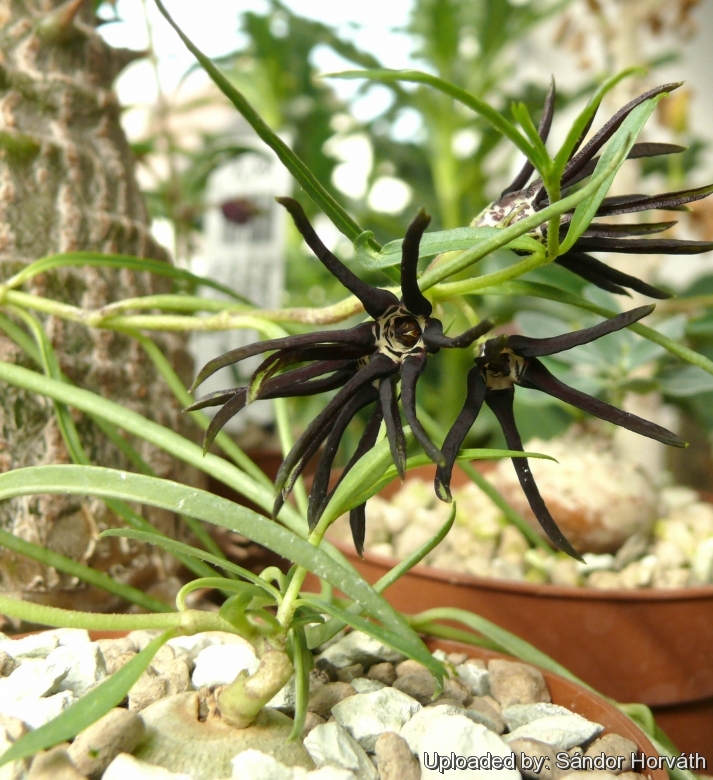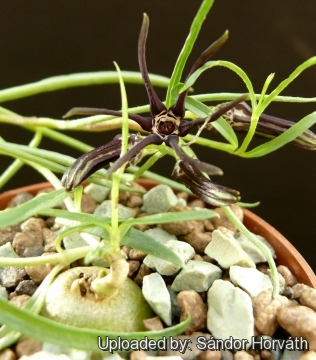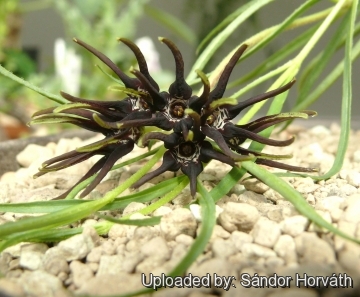




Your support is critical to our success.
- Encyclopedia of SUCCULENTS
- Encyclopedia Index
- Families
- Genera
- Species
- Asclepiadaceae
- Brachystelma
- Caudiciforms
Since 4 Aug 2013

Origin and Habitat: Brachystelma bracteolatum is an exceedingly rare species only known from the type locality: Jos Plateau, SE of Jos, 7 km to Bokkos, 1350m in Nigeria, where it was first discovered by the well-known German nurseryman and botanical explorer Ernst Specks in October 1994.
Habitat and ecology: This species grows on plain granite outcrops, in little depressions filled with humus and sand together with other succulents like Aloe sp., Euphorbia unispinaSN|28018]]SN|28018]] and Huernia nigerianaSN|30474]]SN|30474]]. This Brachystelma has thin grass-like leaves and if growing amongst grassy vegetation they must be very hard to spot, especially when the plants are not in flower. This growth form probably also affords protection by camouflage thus making the plants inconspicuous.
Synonyms:
Description: Brachystelma bracteolatum is a dwarf perennial geophyte growing from a large flattened discoid tuber (caudex) with very conspicuous Crème Coloured/Brown flowers with long, thin petal tips. The umbels of flowers open simultaneously and emanate a disgusting scent that, with no doubt, serve as strong attractants for a large numbers of pollinating flies when the smell is most intense, especially from midday until well into the afternoon. In terms of the scent it has variously described like smell of rotting meat, smell of rotten fish or smell of dung with a sour of lemon/lime. The dark-coloured flowers make a pleasant contrast with the pale green grass-like foliage.
Derivation of specific name: This member of the Asclepiadaceae family was given this name by Ulrich Meve in 1997. The inflorescence bracts and bracteoles are numerous, long-lived and unusually conspicuous for the genus; the specific name refers to these.
Tuber (caudex): Discoidal, smooth, grey-brown 1.5-2.5(-4) cm thick, 5-12 cm in diameter.
Stems: Lax and prostrate, basally several times branched, 10-25 cm long, pale green-reddish, pubescent. The plant produces annual stems and leaves in early spring, but dies back to the tuber during the winter.
Leaves: Almost sessile, linear, acute, grass-like, 30-60 long, about only 1 mm wide, spreading, soft, slightly fleshy, more or less glabrous with small stipular glands attached to the stems.
Inflorescence: First terminal, umbellate, then pushed into lateral position from the shoot continuation, up to 8-flowered, flowering synchronously. Bracts to 2.5 mm long translucent white with reddish tinge. Sepals triangular, 2-3 mm. Pedicels 4-6 mm, long pubescent.
Flowers: 20-25 mm in diameter, strongly foetid, inside wrinkled, glabrous. Corolla tube bowl-shaped, mouth somewhat narrowed, c. 3 mm long, 4-5 mm wide, yellowish, banded with purple-brown. Corolla lobes linear from a triangular base, to 14 mm long and 2 mm wide, acute, ascending, lamina folded back along the midrib, purple-brown. Corona sessile, purple, c. 3 mm hight, 2.2 mm in diameter, basally fused to form a short cup, glabrous. Outer corona-lobes basally pouch-like, free part very short, triangular, 0.4 mm in diameter. Ascending. Inner corona-lobes linear, 2 mm, straight, ascending, connivent above the style head, basally-dorsally bulging; Poll subquadrangular.
Blooming season: The flowers appear in summer ans last for approximately 7−10 days depending on the weather at the time.
Fruits (follicles): One or two follicles per flower, thickly fusiform, to 3 cm long and 1 cm in diameter green-brown mottled with purple.
Similar species: The flowers, with their long, narrow corolla lobes are very characteristics of Brachystelma bracteolatum and are similar to those of Brachystelma lineare to with it forms a complex of strictly related species, but the extremely short interstaminal and the very long ascending staminal corona are uncommon and notable. Brachystelma pellacibellum, Brachystelma johnstonii and Brachystelma floribundum are also closely related.
Bibliography: Major references and further lectures
1) Focke Albers, Ulrich Meve “Illustrated Handbook of Succulent Plants: Asclepiadaceae: Asclepiadaceae”, Volume 4 Springer Science & Business Media, 2002
2) Ulrich Meve “Brachystelma bracteolatum (Asclepiadaceae), a New Species in Nigeria” in: Kew Bulletin Vol. 52, No. 3, 711-714, 1997 [7 Nov 1997]
3) Colin C. Walker “Brachystelma bracteolatum Meve a rare Nigerian endemic” Asklepios 103 (2008)
4) Bullock, A.A. (1963) “Asclepiadaceae” in Hutchinson, J. &
5) Dalziel, M.D. (eds.) “Flora of West Tropical Africa,” 2nd ed., 2: 85–103.
6) Meve, U. & Porembski, S. (1993) “Brachystelma Sims (Asclepiadaceae) in West Tropical Africa.” Bot. Jahrb. Syst., 115: 315–324.
7) Walker, C.C. (1982) “Brachystelma – an introduction and checklist.” Asklepios, 25: 92–106.
8) Walker, C.C. (1998) “Asclepiads in the literature.” Asklepios, 73: 26–31.

Brachystelma bracteolatum Photo by: Sándor Horváth

Brachystelma bracteolatum Photo by: Sándor Horváth
Cultivation and Propagation: In cultivation the plants are usually grown in semi shade, with the tubers wholly or (preferably) partially exposed to prevent scorching and rotting of the roots. This plant can take a good deal of water during active growth and should be watered only when not dormant. Keep dryish in winter. It should be overwintered in the greenhouse at temperatures over 15°C (avoid letting temperatures drop lower than 10° C). Use a very draining but rich soil. An error in cultivation may produce unsightly holes in the tuber.
Reproduction: This species can be reproduced by seeds. Sow seeds in summer in a well drained medium.
| Your Actions | |
|---|---|
| Back to Brachystelma index | |
| Back to Asclepiadaceae index | |
 |
Back to Succulents Encyclopedia index |
Privacy stantement - Terms and conditions - How to cite - About us - Feedback - Donate



